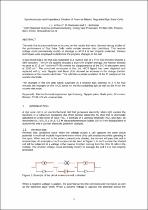JavaScript is disabled for your browser. Some features of this site may not work without it.
- ResearchSpace
- →
- Research Publications/Outputs
- →
- Journal Articles
- →
- View Item
| dc.contributor.author |
Le Roux, Lukas J

|
|
| dc.contributor.author |
Knoesen, D

|
|
| dc.contributor.author |
Hietkamp, S

|
|
| dc.date.accessioned | 2011-03-28T08:02:48Z | |
| dc.date.available | 2011-03-28T08:02:48Z | |
| dc.date.issued | 2011-03 | |
| dc.identifier.citation | Le Roux, L.J., Knoesen, D, and Hietkamp, S. 2011. Spectroscopic and impedance studies of reverse biased degraded dye solar cells. Journal of Solid State Electrochemistry, Vol. 15(3), pp 593-600 | en_US |
| dc.identifier.issn | 1432-8488 | |
| dc.identifier.uri | http://www.springerlink.com/content/qq055255ljj56p2l/fulltext.pdf | |
| dc.identifier.uri | http://hdl.handle.net/10204/4920 | |
| dc.description | Copyright: 2011 Springer. This is the pre print version of the work. The definitive version is published in the Journal of Solid State Electrochemistry, Vol. 15(3), pp 593-600 | en_US |
| dc.description.abstract | The work that is presented here is focused on the results that were obtained during studies of the performance of Dye Solar Cells under certain reverse bias conditions. This reverse voltage could permanently modify or damage a cell if it is not properly protected. Various techniques were employed to determine the physical changes in the cell. It was found that a cell that was subjected to a reverse bias of 2 V for 500 minutes showed a 58% recovery. The UV-Vis spectra showed a blue shift (higher energy), the Raman showed no peak at 1713 cm-1 and the FT-IR showed the disappearance of the S-C-N absorption band at 2100 cm-1. The combined conclusion is that the –NCS ligand has been depleted and replaced with I3- ions. Nyquist and Bode plots showed an increase in the charge transfer resistance at the counter electrode. This indicates a partial oxidation of the Pt catalyst on the counter electrode. The changes in the cell after being subjected to a reverse bias potential of 2 V for 500 minutes are changes on the -NCS bonds on the Ru containing dye as well as the Pt on the counter electrode. | en_US |
| dc.language.iso | en | en_US |
| dc.publisher | Springer | en_US |
| dc.relation.ispartofseries | Workflow;6076 | |
| dc.subject | Electrochemical impedance spectroscopy | en_US |
| dc.subject | Dye solar cells | en_US |
| dc.subject | Nyquist plots | en_US |
| dc.subject | Bode plots | en_US |
| dc.subject | IV-curves | en_US |
| dc.subject | Raman | en_US |
| dc.subject | FT-IR | en_US |
| dc.subject | UV-Vis | en_US |
| dc.subject | Solid state electrochemistry | en_US |
| dc.title | Spectroscopic and impedance studies of reverse biased degraded dye solar cells | en_US |
| dc.type | Article | en_US |
| dc.identifier.apacitation | Le Roux, L. J., Knoesen, D., & Hietkamp, S. (2011). Spectroscopic and impedance studies of reverse biased degraded dye solar cells. http://hdl.handle.net/10204/4920 | en_ZA |
| dc.identifier.chicagocitation | Le Roux, Lukas J, D Knoesen, and S Hietkamp "Spectroscopic and impedance studies of reverse biased degraded dye solar cells." (2011) http://hdl.handle.net/10204/4920 | en_ZA |
| dc.identifier.vancouvercitation | Le Roux LJ, Knoesen D, Hietkamp S. Spectroscopic and impedance studies of reverse biased degraded dye solar cells. 2011; http://hdl.handle.net/10204/4920. | en_ZA |
| dc.identifier.ris | TY - Article AU - Le Roux, Lukas J AU - Knoesen, D AU - Hietkamp, S AB - The work that is presented here is focused on the results that were obtained during studies of the performance of Dye Solar Cells under certain reverse bias conditions. This reverse voltage could permanently modify or damage a cell if it is not properly protected. Various techniques were employed to determine the physical changes in the cell. It was found that a cell that was subjected to a reverse bias of 2 V for 500 minutes showed a 58% recovery. The UV-Vis spectra showed a blue shift (higher energy), the Raman showed no peak at 1713 cm-1 and the FT-IR showed the disappearance of the S-C-N absorption band at 2100 cm-1. The combined conclusion is that the –NCS ligand has been depleted and replaced with I3- ions. Nyquist and Bode plots showed an increase in the charge transfer resistance at the counter electrode. This indicates a partial oxidation of the Pt catalyst on the counter electrode. The changes in the cell after being subjected to a reverse bias potential of 2 V for 500 minutes are changes on the -NCS bonds on the Ru containing dye as well as the Pt on the counter electrode. DA - 2011-03 DB - ResearchSpace DP - CSIR KW - Electrochemical impedance spectroscopy KW - Dye solar cells KW - Nyquist plots KW - Bode plots KW - IV-curves KW - Raman KW - FT-IR KW - UV-Vis KW - Solid state electrochemistry LK - https://researchspace.csir.co.za PY - 2011 SM - 1432-8488 T1 - Spectroscopic and impedance studies of reverse biased degraded dye solar cells TI - Spectroscopic and impedance studies of reverse biased degraded dye solar cells UR - http://hdl.handle.net/10204/4920 ER - | en_ZA |






